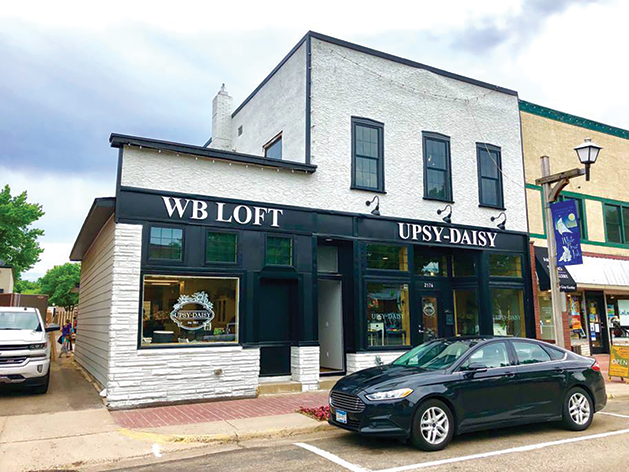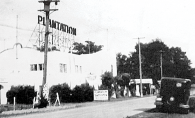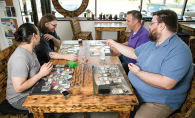
Amid the shops in downtown White Bear Lake is a little furniture store specializing in giving the old new purpose. Now the building the store occupies has gotten a facelift as well, thanks to Eli Rupnow, the building’s new owner.
Upsy Daisy has been in 2176 Third St. for four and a half years, and since she opened the shop, owner Danielle Rode has been curious about the building’s history.
“There’s been a lot of love and care put into revitalizing the building. When you start pulling apart a building that’s been there for so long, you want to start doing research,” says Rode.
Upsy-Daisy was closed last January through June while every floor in the building from the basement up to the third was gutted and restored.
When Rupnow bought the building, he knew he wanted to restore its original look. “I’ve always liked downtown White Bear Lake and the community. Downtown has charm that big box stores can never match,” Rupnow says about his decision to buy the building.
Rupnow has always appreciated the architecture of the late 1800s and early 1900s for its character and quality.
Rupnow is a civil engineer, but says, “Someone reminded me recently that in high school, I wanted to be an architect.” When he updates any building, Rupnow tries to salvage and restore as much as possible, even though that’s never the easiest or least expensive way to go.
“One of the contractors I met with said, ‘It would be easier to take a match to this building and start new,’” says Rupnow, referring to using new materials to approximate the old look.
Rupnow says that while not all the structural components were sound enough to keep intact, he was able to repurpose some of the beams and other wood, for example, by using it to construct a wheelchair-accessible bathroom.
“We were hoping to cosmetically update the upstairs.” Much of the previous work was unsalvageable, but the integrity of the old building’s facade was able to be restored. With the help of Rode, Rupnow was able to make use of a White Bear Lake city program aimed at restoring facades of historic buildings.
Rode and her mother did some investigating into the building’s history, and discovered it housed a meat market in the early 1900s.
“We thought those people, [the owners of the meat market] were the first owners,” says Rode. The improvements on the building garnered a lot of attention in the community, and one woman reached out to Rode and told her she believed her family, who had owned the Goesch dry goods store, originally owned the building back when it was first built. Cynthia E. Vadnais, in her book Looking Back at White Bear Lake: A Pictorial History of the White Bear Lake Area, confirms this. Vadnais writes that William Goesch arrived in White Bear Lake in 1892. His wife was a dressmaker, and they opened the shop together. An 1888 ad reads that the Goesch’s store carried “dry goods, millinery, notions, ready-made clothing, hats, caps, and furnishing goods of all kinds.”
Vadnais writes that Flandrick’s Meat Market succeeded the dry goods store. A White Bear Life ad from 1912 announces that J.A. Flandrick was a dealer in “all kinds of fresh and salt meats, poultry, fish, etc.” Vadnais notes that by 1937, Flandrick’s was White Bear’s oldest business.
“It’s been really fun to unravel the history of the building,” says Rode. “It was in really bad shape and there’s this gorgeous apartment that’s been sitting vacant for six, seven years. People are just super, super excited and really curious.”
The three-bedroom apartment on the top floor was renovated to function as an Airbnb. The work paid off, and the accommodations were booked through most of the summer before it was even completed, with all the guests hearing about it through word-of-mouth.
Like most of the White Bear downtown area, the building is within walking distance of the lake and a favorite for foot traffic browsing the local shops.
“I love the customers and the people that just come in on a Saturday as they’re strolling the square. Even if they don’t buy anything, it’s all really positive. People tell me, ‘It’s so beautiful, I just want to live in here.’ It keeps our energy up,” says Rode.
Rodes is passionate about history, and says the renovated space adds to the energy. Upsy-Daisy was able to use original beams and trim in the shop to enhance the historic feel of the building. Rode’s personal taste lends to the vintage touch as well.
Looking back on the restoration, Rupnow says, “I’m proud of the work. I’m proud that we employed 40 to 50 local people on the construction.” Rupnow says that as with all building projects, there were surprises along the way. “With an old building, you never know what you’ll find,” he says. “And as with any project, there were some creative differences. But after all the surprises, I’m very happy with the result.”











